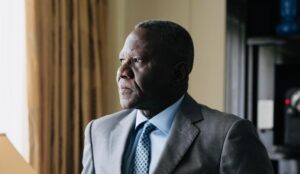
n the bustling city of Lagos, Nigeria, Ibrahim Adewale stood by the window of his office, watching the sun set over the horizon. As the CEO of a growing fintech company, he had to make critical decision almost daily. Each choice he made rippled through the entire organization, influencing his employees, clients, and stakeholders. Ibrahim understood that leadership wasn’t just about giving orders; it was about making informed decisions, and doing so wisely. But what were the best practices that guided him and other successful leaders across Africa?
1. Understanding the Bigger Picture
In Nairobi, Kenya, Layla Otieno had risen to prominence as the head of an influential NGO. Her organization focused on providing educational resources to underprivileged children. Layla’s leadership style involved seeing the bigger picture. Every decision she made, whether it was about allocating resources or forming partnerships, was guided by a clear vision of her organization’s goals.
Like Ibrahim, Layla understood that successful leaders must always have the end goal in mind. When faced with a challenging decision, she would ask herself, “How will this decision impact the organization’s mission?” This holistic approach allowed her to make decisions that not only addressed immediate issues but also contributed to the long-term sustainability of her organization.
Leaders who can grasp the larger context tend to make more strategic decisions. They don’t just react to immediate circumstances but consider how their choices align with their vision and objectives.
2. Data-Driven Decision Making
In Accra, Ghana, Kwame Mensah sat in a meeting room, surrounded by charts, spreadsheets, and analytics reports. As the director of a large manufacturing company, Kwame had learned the importance of using data to drive his decisions. He knew that relying solely on intuition could lead to costly mistakes. Instead, he combined his experience with concrete data to ensure his decisions were well-informed.
One of Kwame’s most successful decisions involved expanding into new markets. Rather than rushing into the expansion based on a gut feeling, he spent months analyzing data from market trends, customer preferences, and financial forecasts. The data revealed potential risks and opportunities that helped him navigate the expansion smoothly.
Data-driven decision-making allows leaders to minimize uncertainty and make choices based on facts. This approach ensures that decisions are not just influenced by personal biases or emotions but grounded in evidence.
3. Empowering the Team
In Cape Town, South Africa, Ntombi Dlamini believed in the power of collaboration. As the manager of a leading advertising agency, she had learned early in her career that making decisions in isolation could stifle creativity and limit perspective. Ntombi regularly consulted with her team when faced with major decisions.
One of her most memorable moments came during a campaign pitch for a high-profile client. The client’s brief was vague, and Ntombi struggled with which direction to take. Instead of making a unilateral decision, she invited her team to brainstorm and share ideas. The result was a creative solution that impressed the client and won them the contract.
Empowering teams to participate in decision-making fosters a culture of collaboration and innovation. Leaders like Ntombi understand that their teams bring diverse perspectives, and when included in the process, employees feel valued and motivated. This approach also distributes decision-making responsibilities, ensuring the leader isn’t solely burdened with every choice.
4. Balancing Short-Term and Long-Term Goals
In Addis Ababa, Ethiopia, Tesfaye Alemu ran a successful agribusiness. As the demand for his company’s organic products grew, Tesfaye often found himself torn between immediate profits and long-term growth. He knew that expanding his operations could bring in more revenue quickly, but it also risked overextending the company’s resources.
Tesfaye’s solution was to strike a balance between short-term and long-term goals. He would occasionally take calculated risks for short-term gains, but never at the expense of the company’s sustainability. One year, after careful analysis, he decided to invest in new technology that would improve productivity in the long run, even though it meant lower profits in the short term. This decision ultimately positioned his business for sustainable growth and solidified his reputation as a forward-thinking leader.
Leaders who master the art of balancing short-term wins with long-term strategy are better equipped to navigate the ups and downs of the business world. They understand that a focus on immediate results shouldn’t come at the cost of future success.
5. Flexibility and Adaptability
In Dakar, Senegal, Fatou Ndiaye faced an unprecedented challenge when her tech startup was hit hard by a sudden economic downturn. She had built her company with a clear plan in mind, but the changing market conditions demanded swift and radical adjustments.
Fatou quickly realized that leadership was not about rigid adherence to a plan but about adaptability. She gathered her team and explored new strategies, pivoting their business model to focus on more resilient revenue streams. Instead of relying solely on their initial product, they expanded into new areas of technology that were thriving during the economic crisis. This flexibility allowed Fatou’s startup to not only survive but thrive during a turbulent time.
Adaptability is crucial for leaders in today’s fast-paced world. Circumstances can change quickly, and leaders who can pivot and adjust their strategies are better positioned to succeed. Flexibility doesn’t mean abandoning principles but being open to new ways of achieving goals.
6. Emotional Intelligence in Decision Making
In Dar es Salaam, Tanzania, Asha Mwinyi managed a healthcare organization that served rural communities. One of the hardest decisions she ever had to make involved cutting costs during a financial crunch. While data showed that cutting certain services would save money, Asha understood the human impact of such decisions. Her leadership style emphasized emotional intelligence, allowing her to balance logic with empathy.
Rather than making cold, data-driven decisions, Asha sought feedback from her staff and patients. She listened to their concerns, which helped her find a solution that minimized the negative impact on the communities they served. Her empathetic approach earned her the trust of both her team and the people she was committed to helping.
Emotional intelligence enables leaders to consider the emotional and human factors in decision-making. Leaders like Asha understand that their choices affect people’s lives, and they strive to balance rational decisions with compassion.
7. Learning from Mistakes
In Windhoek, Namibia, John Kazondunge reflected on a decision he had made years ago. As the owner of a logistics company, he had once rushed into purchasing a fleet of trucks without thoroughly assessing the financial impact. The decision led to a temporary cash flow crisis that nearly crippled his business.
John, however, learned from his mistake. Rather than seeing it as a failure, he viewed it as a learning opportunity. He introduced more rigorous financial planning processes and became more cautious in making large investments. This experience helped him grow as a leader, and his company became stronger as a result.
Learning from mistakes is an essential quality of effective leadership. Leaders who embrace their missteps, analyze what went wrong, and apply those lessons to future decisions are more likely to grow and succeed.
Conclusion
From Lagos to Nairobi, Accra to Addis Ababa, the best practices in leadership and decision-making remain consistent across diverse settings. Successful leaders understand the importance of seeing the bigger picture, using data to guide decisions, empowering teams, balancing short- and long-term goals, and adapting to change. They also recognize the value of emotional intelligence and learning from mistakes.
Leaders like Ibrahim, Layla, Kwame, Ntombi, Tesfaye, Fatou, Asha, and John demonstrate that effective decision-making is not a one-size-fits-all approach. It requires a blend of strategy, collaboration, adaptability, and empathy. Above all, great leaders make decisions that reflect their values, ensuring that their choices benefit not only their organizations but also the communities they serve.








